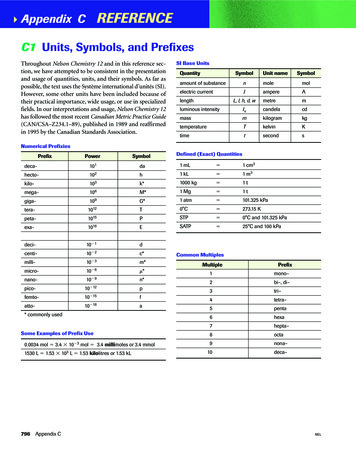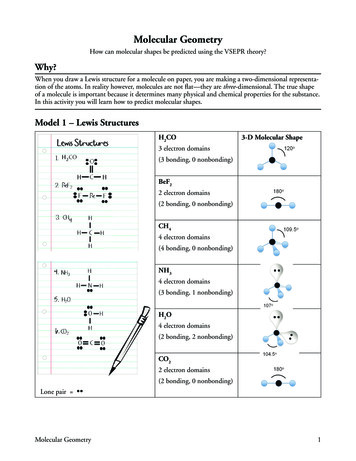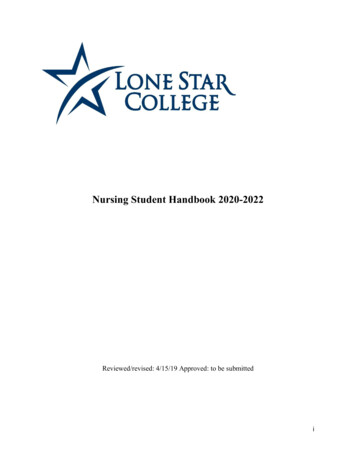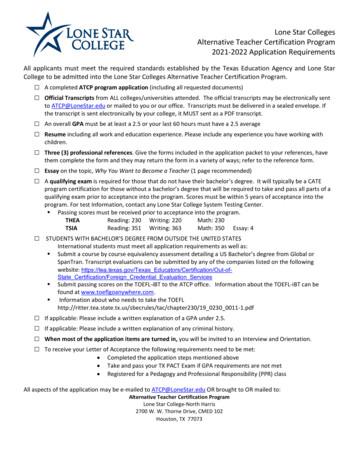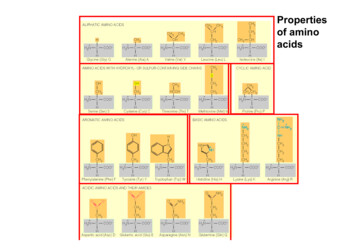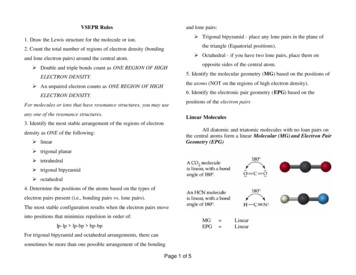
Transcription
VSEPR Rulesand lone pairs:Ø Trigonal bipyramid - place any lone pairs in the plane of1. Draw the Lewis structure for the molecule or ion.the triangle (Equatorial positions).2. Count the total number of regions of electron density (bondingØ Octahedral - if you have two lone pairs, place them onand lone electron pairs) around the central atom.opposite sides of the central atom.Ø Double and triple bonds count as ONE REGION OF HIGH5. Identify the molecular geometry (MG) based on the positions ofELECTRON DENSITY.the atoms (NOT on the regions of high electron density).Ø An unpaired electron counts as ONE REGION OF HIGH6. Identify the electronic pair geometry (EPG) based on theELECTRON DENSITY.For molecules or ions that have resonance structures, you may useany one of the resonance structures.positions of the electron pairsLinear Molecules3. Identify the most stable arrangement of the regions of electronAll diatomic and triatomic molecules with no loan pairs onthe central atoms form a linear Molecular (MG) and Electron PairGeometry (EPG)density as ONE of the following:Ø linearØ trigonal planarØ tetrahedralØ trigonal bipyramidØ octahedral4. Determine the positions of the atoms based on the types ofelectron pairs present (i.e., bonding pairs vs. lone pairs).The most stable configuration results when the electron pairs moveinto positions that minimize repulsion in order of:MGEPGlp- lp lp-bp bp-bpFor trigonal bipyramid and octahedral arrangements, there cansometimes be more than one possible arrangement of the bondingPage 1 of 5 LinearLinear
Trigonal Planar and Bent MoleculesExamples are:For a central atom bonding 3 atoms with no lone pairs, the MG EPG Trigonal Planar.For a central atom bonding 2 atoms with 1 or 2 lone pairs, the MG Bent and the EPG trigonal planar.Tetrahedral EPGWhen a central atom has 4 regions of electron density (lp & bp) theEPG is defined by a Tetrahedron.A central atom with 4 bonds has a MG tetrahedral and an EPG tetrahedral.Page 2 of 5
When there are 3 bonds and one lone pair as in ammonia (NH3 ),the structure has a MG trigonal pyramid while retaining the EPG tetrahedral. The lone pair pushes the bonding pairs down out ofthe molecular plane to form the trigonal pyramid geome try.In the case of water (H2 O) the two lone pairs force the molecule tobend into an angle. The MG bent while the 4 electron pairsmaintain a EPG tetrahedral.Expanded ValencesWhen a central atom is surrounded by 5 electron pairs, as is thecase for an expanded valence, a Trigonal Bipyramid alwaysdescribes the EPG.In the case of SF4 , the lone pair resides in an equatorial positioncreating a “See Saw” molecular geometry for the structure.This is the lowest energy conformation since there are two 90 lpbp interactions and two 120 lp-bp interactions. In the axialposition, there would be three 90 interactions. This would resultin a higher energy (less favorable) conformation.The EPG remains trigonal bipyramid as there are 5 total regions ofelectron density.PCl5 is an example of an expanded valence compound that has atrigonal bipyramid MG and EPG.Since phosphorous is in the 3rd period, the 5 valence electrons canprovide bonding for up to 5 atoms as seen to the right.Page 3 of 5
When a molecule has 5 electron pairs, 2 of which are lone pairs,the lone pairs reside in the equatorial positions forcing the bondingatoms into a “T-Shaped” molecular geometry.Some expanded valence compounds will have a total of 6 electronpairs (bp & lp) around a central atom.In this case, the EPG is described by a “octahedron” and EPG iscalled Octahedral.When a molecule that has a trigonal bipyramid EPG contains 2bonds and 3 lp, the lp will occupy the equatorial positions to formthe lowest energy confirmation. The result as in I3 - is a linearmolecular geometry (MG) with both I-I bonds in the axialpositions.In SF6 , each of the 6 valence electrons in sulfur expands to form abond with a F-atom. This results in a octahedral MG and EPG forthe molecule.Page 4 of 5
When an octahedral EPG contains 5 bonds and 1 lp, the lp willoccupy and of the 6 positions as all are equivalent. The result is amolecular geometry that is described by a square pyramid. (like inEgypt) The MG is then called “Square Pyramidal”.When an octahedral EPG has 4 bonds and 2 lp, the two lp willoccupy positions opposite of one another to form the most stableconformation. The result is a “Square Planar” MG as in XeF4 .The following tables summarize the examples of each VESPR caselisted. For more information please consult your text, the libraryand of course, the web!All figures courtesy of “Chemistry”, John McMurry & Robert C.Fay 3rd edition, Prentice Hall Publications.Page 5 of 5
When there are 3 bonds and one lone pair as in ammonia (NH 3), the structure has a MG trigonal pyramid while retaining the EPG tetrahedral. The lone pair pushes the bonding pairs down out of the molecular plane to form the trigonal pyramid geometry. In the case of water (H 2O) the two lone pairs force the molecule to bend into an angle.
